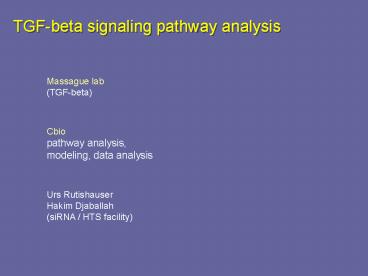Cbio pathway analysis, modeling, data analysis - PowerPoint PPT Presentation
1 / 30
Title:
Cbio pathway analysis, modeling, data analysis
Description:
Hakim Djaballah (siRNA / HTS facility) TGF-beta signaling pathway analysis. TGF-beta pathway ... Complexity at the ligand/receptor level. What other components ... – PowerPoint PPT presentation
Number of Views:64
Avg rating:3.0/5.0
Title: Cbio pathway analysis, modeling, data analysis
1
TGF-beta signaling pathway analysis
Massague lab(TGF-beta)
Cbiopathway analysis, modeling, data analysis
Urs RutishauserHakim Djaballah(siRNA / HTS
facility)
2
TGF-beta pathwayTGFb
TGF?1
TGF? RII Type II receptor
Alk5 Type I receptor
Joan Massagué
3
TGF-beta pathwayBMP
Activin RII Type II receptor
Alk2 Type I receptor
4
TGF-beta pathway
42 different ligands (incl. antagonists)
2 I-Smads
5 different Type II receptors
7 different Type I receptors
1 Co-Smad
6 R-Smads
5
Complexity at the ligand/receptor level
Gene expression program 1
Gene expression program 2
6
Questions
- What other components are involved?
- Identify new pathway members
- Understand signaling mechanisms Crosstalk
between different receptors - Explanation for role-reversal of TGF-beta from
growth-suppressor to activator?
7
Biological assay
- Activation and perturbation (siRNA)
- Test different combinations of ligands and
overexpressed / repressed receptors - Live-cell assays (time course)
- High-throughput assays
8
Assay system
- Activation of the pathway
- Phosphorylation / localization of Smad1/2 (in
parallel) - Signal transduction to the nucleus
- Transcription of Smad1/2-responsive targets genes
9
Probing the TGF-beta pathwayStimulation with
different combinations and concentrations of
ligands // RNAi knockdowns
42 different ligands
cytoplasm
5 different Type II receptors
Smad1 (BMP)Smad2 (TGF-beta)
7 different Type I receptors
nucleus
activated Smad complex
co-activator or co-repressor
cell-specific DNA-binding cofactors
Smad1/2-responsive genes
Smad4
10
Probing the TGF-beta pathwayStimulation with
different combinations and concentrations of
ligands // RNAi knockdowns
42 different ligands
cytoplasm
5 different Type II receptors
Smad1 (BMP)Smad2 (TGF-beta)
7 different Type I receptors
nucleus
1
activated Smad complex
co-activator or co-repressor
cell-specific DNA-binding cofactors
Smad1/2-responsive genes
Smad4
1
Pathway activationnuclear translocation of
Smad-FP fusions Option 1 (red/green) Option 2
(blue/yellow) mRFP1-Smad1 Cerulean-Smad1
EGFP-Smad2 Venus-Smad2
11
Probing the TGF-beta pathwayStimulation with
different combinations and concentrations of
ligands // RNAi knockdowns
42 different ligands
cytoplasm
5 different Type II receptors
Smad1 (BMP)Smad2 (TGF-beta)
7 different Type I receptors
nucleus
1
activated Smad complex
co-activator or co-repressor
2
cell-specific DNA-binding cofactors
Smad1/2-responsive genes
Smad4
1
2
Pathway activationnuclear translocation of
Smad-FP fusions Option 1 (red/green) Option 2
(blue/yellow) mRFP1-Smad1 Cerulean-Smad1
EGFP-Smad2 Venus-Smad2
Transcriptiondetect Smad-responsive genes mRFP1
(red) coupled to Smad1-specific promoterVenus
(yellow) coupled to Smad2-specific
promoteralternatively assay Smad-responsive
genes by qPCR
12
Assay details
Smad localization assay Cerulean-Smad1
(cyan)Venus-Smad2 (yellow) AlternativesmRFP-Sm
ad1 (red)EGFP-Smad2 (green)
Transcriptional assay
13
Assay details
Smad localization assay Cerulean-Smad1
(cyan)Venus-Smad2 (yellow) AlternativesmRFP-Sm
ad1 (red)EGFP-Smad2 (green)
Transcriptional assay Low temporal
resolutionPAI-1-mRFP1 (red)Vent2-Venus
(yellow) Higher temporal resolutionPAI-1-nitrore
ductase (red)Vent2-beta-lactamase (green to blue)
U87MG glioblastoma cell line assay has to
be expanded to multiple cell lines
14
Progress
- Lab work
- - make DNA constructs / plasmids
- - test constructs in cells
- make cell lines
- test siRNA
- adapt to HTS
15
(No Transcript)
16
(No Transcript)
17
Cytoscape
18
HaCaT-EGFP-Smad2, fixed
19
(No Transcript)
20
EGFP-Smad2 in HaCaTlive cell imaging,
unstimulated
21
EGFP-Smad2 in HaCaT keratinocyteslive cell
imaging, stimulated (TGF-beta 1 h)
22
EGFP-Smad1 in HaCaTlive cell imaging,
unstimulated
23
EGFP-Smad1 in HaCaTlive cell imaging, stimulated
with BMP 1h
24
U87MG Smad2 stimulated
25
mRFP1-Smad2
26
In Cell analyzer
High-throughput automated individual-cell image
acquisition and analysis Multiple fluorescent
reporters
27
Signaling pathway analysisCombination of
computational and wet-lab biology
Genomic data Expression data Computational
models Literature mining
High-throughput experiments Test models
28
- Lab work
- - make DNA constructs / plasmids
- - test constructs in cells
- make cell lines
- test siRNA
- adapt to HTS
- Literature / computational
- define known pathway
29
Gene Atlas
Gene expression data from 79 human tissues, 60
mouse Idea to analyze expression of ligands,
receptors, Smads across all tissues and look for
preferences / biases Compare these biases to
expression levels of known Smad1/2-responsive
genes ? comparison of MSKCC tumor samples
30
Target genes for siRNA experiments
Identify potential pathway members based on
similarities to known pathway members Gene /
Protein expression patterns Protein sequence
and domain composition Genomic proximity
Shared promoter elements































